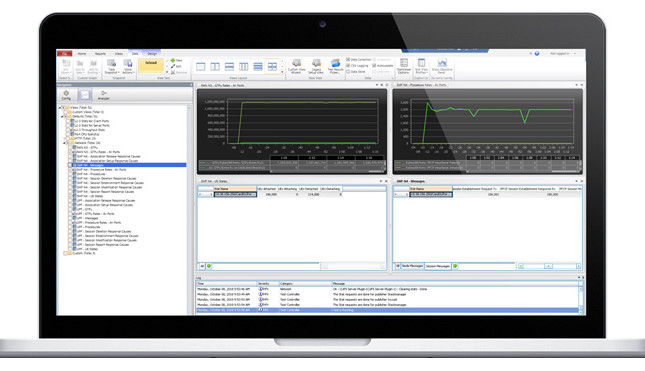Keysight Launches New 5G Core Network Test Solution - LoadCore
April 29, 2020
on
on

Keysight Technologies, Inc. (NYSE: KEYS), a leading technology company that helps enterprises, service providers and governments accelerate innovation to connect and secure the world, announced LoadCore 5G Core (5GC) Testing software – and China Mobile Research Institute (CMRI) has selected LoadCore to validate performance using 5GC network equipment provided by major infrastructure vendors.
To take full advantage of new mobile communications standards, mobile operators are moving from an evolved packet core (EPC) to 5GC. By combining 5G NR deployment in standalone (SA) mode with a virtualized network architecture, operators can efficiently use network slicing to allocate resources for different use cases. As a result, mobile operators need to manage a massive number of devices and connections in support of service level agreements (SLAs) for both consumers and industry.
Keysight’s LoadCore 5GC Testing software simulates complex real-world subscriber models to enable mobile operators and network equipment manufacturers (NEMs) to qualify performance and reliability of voice and data transferred over 5GC networks. Carrier-grade quality of service (QoS) benefits consumers accessing data intensive applications, such video and gaming and businesses that rely on critical IoT applications in sectors such as automotive, manufacturing, energy and utilities.
Keysight’s LoadCore 5GC Testing software is part of an integrated test solution portfolio that enables a connected ecosystem to consistently validate the performance of the network from the edge of the RAN to the cloud. To verify that wireless applications, using either 4G or 5G technology, fulfill the expectations of end-users, Keysight’s test solutions allow mobile operators and network equipment manufacturers (NEMs) to validate both 5G and legacy radio access networks (RANs), as well as the 5GC.
“5G networks require advanced capabilities to be verified including elastic scaling of network nodes, network slicing and multi-access edge computing (MEC) when simulating the behavior of millions of UEs,” said Kalyan Sundhar, vice president and general manager of Keysight’s Edge-to-Core Group. “Keysight’s new LoadCore 5GC cloud-native testing software enables service providers and network equipment manufacturers to validate the 5G Core networks as they progress from development to deployment.”
“We’re pleased to support China Mobile successfully transition from 4G to 5G using test solutions that support an ambitious 5G deployment strategy, which already services over 50 major cities across China,” said Steve Yan, vice president of sales for Greater China at Keysight Technologies. “Keysight’s LoadCore enables CMRI to swiftly and reliably verify that deployed 5G network equipment supports complex user and traffic models today and in the future.”
Keysight’s LoadCore 5GC Testing software enables users to perform network capacity tests, measure device data throughput and model a wide variety of end-user behavior and mobility scenarios. As a scalable 5GC network performance validation solution, it can verify that delivered connectivity service remains stable under various demanding conditions such as sudden spikes in network usage caused by disasters or other major events.
To take full advantage of new mobile communications standards, mobile operators are moving from an evolved packet core (EPC) to 5GC. By combining 5G NR deployment in standalone (SA) mode with a virtualized network architecture, operators can efficiently use network slicing to allocate resources for different use cases. As a result, mobile operators need to manage a massive number of devices and connections in support of service level agreements (SLAs) for both consumers and industry.
Keysight’s LoadCore 5GC Testing software simulates complex real-world subscriber models to enable mobile operators and network equipment manufacturers (NEMs) to qualify performance and reliability of voice and data transferred over 5GC networks. Carrier-grade quality of service (QoS) benefits consumers accessing data intensive applications, such video and gaming and businesses that rely on critical IoT applications in sectors such as automotive, manufacturing, energy and utilities.
Keysight’s LoadCore 5GC Testing software is part of an integrated test solution portfolio that enables a connected ecosystem to consistently validate the performance of the network from the edge of the RAN to the cloud. To verify that wireless applications, using either 4G or 5G technology, fulfill the expectations of end-users, Keysight’s test solutions allow mobile operators and network equipment manufacturers (NEMs) to validate both 5G and legacy radio access networks (RANs), as well as the 5GC.
“5G networks require advanced capabilities to be verified including elastic scaling of network nodes, network slicing and multi-access edge computing (MEC) when simulating the behavior of millions of UEs,” said Kalyan Sundhar, vice president and general manager of Keysight’s Edge-to-Core Group. “Keysight’s new LoadCore 5GC cloud-native testing software enables service providers and network equipment manufacturers to validate the 5G Core networks as they progress from development to deployment.”
“We’re pleased to support China Mobile successfully transition from 4G to 5G using test solutions that support an ambitious 5G deployment strategy, which already services over 50 major cities across China,” said Steve Yan, vice president of sales for Greater China at Keysight Technologies. “Keysight’s LoadCore enables CMRI to swiftly and reliably verify that deployed 5G network equipment supports complex user and traffic models today and in the future.”
Keysight’s LoadCore 5GC Testing software enables users to perform network capacity tests, measure device data throughput and model a wide variety of end-user behavior and mobility scenarios. As a scalable 5GC network performance validation solution, it can verify that delivered connectivity service remains stable under various demanding conditions such as sudden spikes in network usage caused by disasters or other major events.
Read full article
Hide full article



Discussion (0 comments)